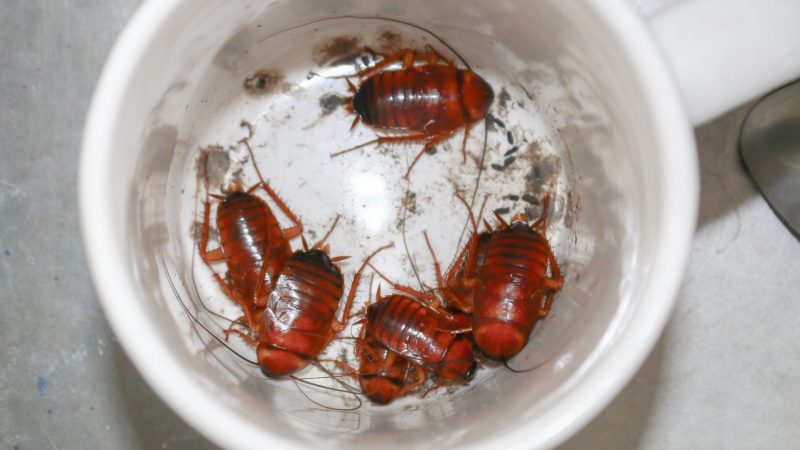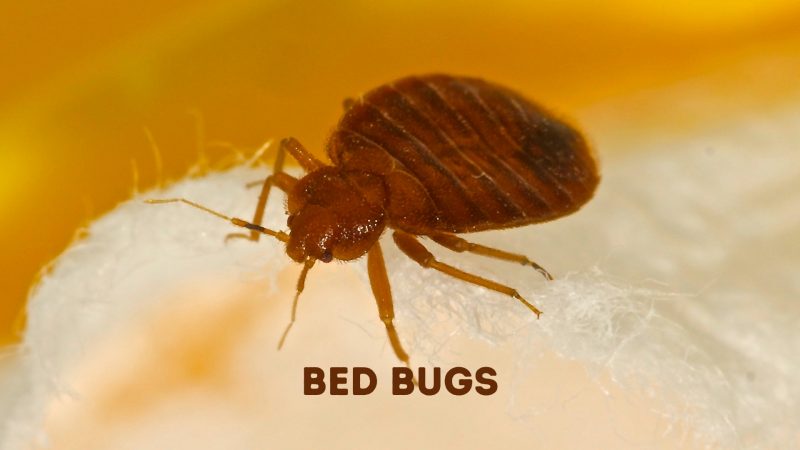Cockroaches pass through a few stages of development. The egg, several nymph stages, and, finally, the adult. Baby cockroaches are the ones that are still in their nymph phase.
What do baby cockroaches look like? Baby cockroaches look pretty much the same as the adults, but smaller. Moreover, the color might differ a bit. For example, American cockroach nymphs begin with a black-brown color. After that, the babies shed their exoskeletons and, ultimately, change their color to reddish-brown.
The nymphs of different cockroaches can be anywhere from an eighth of an inch long (German cockroach babies) to approximately three-eighths (the nymphs of a Smoky brown cockroach).
There is a lot more to know about these mysterious creatures. What do baby cockroaches eat? Do they fly? Can they bite? Can baby cockroaches be mistaken for bed bugs? In the following section below you will find all the information you need to know and more. Let’s begin!
Baby Cockroach – Information
How Many Babies Do Cockroaches Have?
Cockroaches don’t exactly lay eggs. They produce a dark-colored case that contains eggs. Each ootheca has anywhere between 16 and 50 eggs (depending on the species). A female American cockroach, for example, will produce about 6-14 cases during her lifespan. After some time, eggs will hatch into nymphs.
Do Baby Cockroaches Fly?
Baby roaches do not fly. Some adults can use their wings to fly or glide. However, the wings of a nymph are either nonexistent or underdeveloped.
What Is Baby Cockroach Called?
An immature form of cockroach is known as a “nymph”. But you can also call it a “baby cockroach”.
Where Do Baby Cockroaches Come From?
Nymphs come from egg cases – oothecae. Each egg produces a single baby. Some of those might not hatch, but there still will be quite a lot of nymphs coming from one ootheca (from 16 to 50).
Can Baby Cockroaches Jump?
Fortunately, baby cockroaches cannot jump as their legs are not able to do that. There is one single cockroach species that can leap (up to 50 lengths of its body!). This creature is called “leaproach” and it can be found only in the Table Mountain National Park in South Africa.
What Do Baby Cockroaches Eat?
Just like adults, baby cockroaches can eat almost anything. Most of the time, they feed on rotten food and anything they can find in the garbage.
Are Baby Cockroaches Fast?
Yes, nymphs move very quickly, almost as fast as their parents which is about 3 miles per hour.
Are Baby Cockroaches Nocturnal?
Any type of cockroach is mostly nocturnal. But that does not mean that you’ll never find these insects running around during day time. Even though they do prefer to hide during the day, they might crawl out in search of food or if disturbed.
Can Baby Cockroaches Lay Eggs?
Only adult females can lay eggs. It takes a little over a hundred days for a German cockroach nymph to become an adult. Only once they grow up, they are able to mate and reproduce.
Do Baby Cockroach Bite?
Baby roaches are not known for biting humans. But they can do that by accident. For example, if a person is fast asleep but there are food crumbs on his body, the baby cockroach might accidentally bite the skin while snacking on the food source.
Baby Cockroach Size

How Big Are Baby Cockroaches?
The size of a nymph depends on the cockroach species. Usually, baby roaches are anywhere between an eighth and three-eighth of an inch long.
How Big Are Baby German Cockroaches?
The nymphs of a German cockroach are around an eighth of an inch in length.
How Big Are Baby American Cockroaches?
The babies of American cockroaches are a bit bigger – about a quarter of an inch.
How Big Are Baby Hissing Cockroaches?
Their nymphs are one-quarter of an inch long.
How Big Are Baby Oriental Cockroaches?
The babies of Oriental cockroaches are also a quarter of an inch in length.
Different Types of Baby Cockroaches and What Do They Look Like?
Baby German Cockroach
The nymphs are dark-brown (almost black) in color. The baby has a flat, hard-shelled body (nearly oval in shape), as well as 6 legs, a distinctly separate head, and 2 long antennae. Unlike an adult, a baby German cockroach does not have wings.
Baby American Cockroach
The babies begin with a black-brown color. They are oblong in shape; have 6 legs, 2 long antennae, and a flattened, hard-shelled body. At the base, the nymphs have appendages. Just like a baby German cockroach, a nymph of an American roach does not have any wings.
Baby Oriental Cockroach
These nymphs are relatively big and have a reddish-brown color. The babies of an Oriental roach are oblong in shape, have 6 legs, medium-length antennae, and a flattened, hard-shelled body (it’s also shiny). The nymphs don’t have wings, but they do have cerci.
Baby Flying Cockroach
An American cockroach, for example, uses its wings to glide, while Asian and brown cockroaches are very capable flyers. However, all nymphs either have underdeveloped wings or don’t have them at all (in most cases). So, you won’t be able to encounter a baby flying cockroach.
Brown-Banded Cockroach Baby
Just like the adults, the nymphs of a brown-banded cockroach have a brown body with two wide, light bands behind the head. The baby is squatly oblong, has 6 legs, 2 slender antennae, and a shiny, hard-shelled body.
Baby Hissing Cockroach
When the nymphs of hissing cockroaches are born, they are completely white. But they will darken as soon as their exoskeleton hardens (in about a few hours). While the body is white, you can vividly see the big, black eyes of the nymph.
Asian Cockroach Baby
The nymphs of an Asian cockroach are practically identical to those of a German cockroach. The babies of this species are just a little smaller.
Smoky Brown Cockroach Baby
The nymphs are much darker in color than adults. They also feature two white stripes. The tips of their antennas are also white.
Baby Australian Cockroach
The babies from Australian cockroaches are much smaller than adults. They don’t have wings, but you will spot yellow splotches along their backs.
Are Baby Cockroaches Immune to Pesticides?
Unfortunately, these annoying creatures are becoming immune to pesticides. Let’s imagine that 100 roaches are sprayed with a chemical insecticide. Well, 95 of those will get killed, but the other 5 will survive. These are the insects that were already resistant to some insecticides.
The worst thing about this fact is that adult cockroaches will pass this “resistance” gene to their babies. So, if its parents were immune to chemicals, then the nymph is going to be resistant as well.
Related: How to Get Rid of Baby Cockroaches | Practical Tips and Prevention Guide
Baby Cockroach vs Bed Bug

It is practically impossible to mistake an adult cockroach for a bed bug. However, baby roaches really do have a lot in common with bed bugs. Of course, it is important to know what insect you are dealing with, so here are some tips that will help you differentiate between a nymph and a bed bug.
Baby cockroaches are usually smaller than bed bugs. The bodies of bed bugs are flatter and more oval and their antennae will be shorter than those of a nymph. One of the main differences is the insects’ eyes – a bed bug has distinct eyes that stick out from the rest of the body.
Bugs That Look Like Baby Cockroaches
We have already found out that bed bugs can be mistaken for nymphs (especially, the babies of a German cockroach). There are no other bugs that look that similar to their nymphs. Mainly, because of the size difference.
Adult roaches might resemble various bugs but there are distinct differences that you will be able to see upon closer inspection.
Related: Bugs That Look Like Baby Roaches | Identification and Comparison
10 Facts About Baby Cockroaches
1. The cockroach eggs hatch because of the combined pressure of the hatchlings inside. To become bigger, the babies intake air.
2. As soon as the nymph emerges from the case, it’s white. But within a few hours, it will darken and harden.
3. Depending on the species of the cockroach, the nymph will develop into an adult in a few months or, in some cases, a year.
4. The nymphs darken with each progressive molt.
5. The process of molting is called “ecdysis”.
6. Shedding its skin is the only way the baby can grow – its hard outer cuticle doesn’t allow expansion.
7. The old skin splits right down the back and then the nymph has to get its body out of the cuticle. Some babies might get eaten during this stage or simply die because they are unable to get out of their old skin.
8. Molted skins and the saliva of baby cockroaches can trigger allergic reactions.
9. The nymph stage of a German cockroach lasts 55-68 days. During this time, the baby will molt 6-7 times.
10. After the final molt, the now-adult comes out of the old skin with wings for the first time. The roach at that point finally has functioning reproductive organs.
List of Sources
Cockroaches, University of Minnesota
Potter M., Cockroach Elimination in Homes and Apartments, University of Kentucky
- Bed Bug Surge 2025: How to Detect, Prevent, and Safely Eliminate Infestations in Top U.S. Cities - June 18, 2025
- Asian Needle Ants Invade US Homes: 2025 Guide to Identification, Risks, and Effective Control - June 11, 2025
- New World Screwworm Alert: How US Livestock Owners Can Prevent Outbreaks and Protect Herds [Summer 2025 Update] - June 8, 2025
